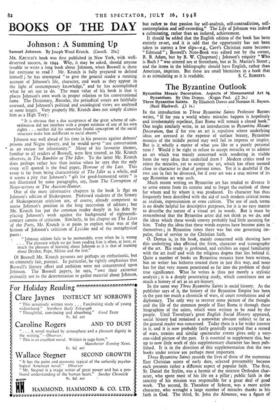The Byzantine Outlook
Byzantine Mosaic Decoration. Aspects of Monumental Art hi Byzantium. By Otto Demus. (Kegan Paul. £2 2s.)
Three Byzantine Saints. By Elizabeth Dawes and Norman H. Baynes. (Basil Blackwell. £1 Is.) •
IN the introduction to Three Byzantine Saints Professor Baynes writes, "If for you a world where miracles happen is hopelessly and irredeemably repellent, East Rome will remain a closed book." One might similarly write, in an introduction to Byzantine Mosaic Decoration, that if for you an art is repulsive where underlying ideas are stressed at the expense of surface beauty, Byzantine mosaics of the middle period may well fail to impress or inspire. But is it wholly a matter of what you like or a purely personal taste ? Would it be right to refuse to accept miracles or to admire an art which was mainly concerned with rendering in visible form the very ideas that underlaid them ? Modern critics tend to reject the miracles, yet to accept the art, which has often seemed close in characterto that of present times. Yet it is doubtful if the two can in fact be divorced, for if ever art was a true mirror of its age Byzantine art was such.
Much recent writing on Byzantine art has tended to divorce it to some extent from its context and to forget the outlook of those for whom and by whom it was produced. Its character has thus frequently been described with the aid of such modern critical terms as realism, expressionism or even cubism. The use of such terms is no doubt helpful for descriptive purposes, for it is no easy matter to describe the nature of a visual art in words. But it must be remembered that the Byzantine artist did not think as we do, and the ideas which these words convey probably had little meaning for him. Today the ideas that these words express have become aims in themselves ; in Byzantine times there was but one governing im- pulse, that of service to the Christian faith.
0. Demus is, in his book, mainly concerned with showing how this underlying idea affected the form, character and iconography of the art. His study is profound, and exhibits an equal familiarity with the art itself and with the religious dogma that lies behind it. Quite a number of books on Byzantine mosaics have been written, but no writer has hitherto treated them in just this way, and none has for that very reason penetrated so far into the problem of their true significance. What he writes is thus not merely a stylistic analysis ; it is a deeply penetrating study, which constitutes not so ,much a history of art as an art-history.
In the same way Three Byzantine Saints is social history. As the publisher says of it, the history of the Byzantine Empire has been in the past too much a chronicle of wars, of court revolutions and of diplomacy. The only way to recover some picture of the thought and the life of the common people of East Rome is through these biographies of the saints, which were written to be read by the people. Until Trevelyan's great English Social History appeared, social history had remained a somewhat obscure subject so far as the general reader was concerned. Today there is a far wider interest • in it, and it is now probably fairly generally accepted that a record of wars, treaties and similar. spectacular events gives only a very- one-sided picture of the past. It is essential to supplement this, but up to now little work of this supplementary character has been pub- lished. It is in the direction of this supplementation that the two books under review are perhaps most important.
Three Byzantine Saints records the lives of three of the numerous East Christian saints of early date, selected presumably because each presents rather a different aspect of popular faith. The first, St. Daniel the Stylite, was a hermit of the strictest Orthodox char- acter, who spent most of his life on a pillar ; public faith in the sanctity of his mission was responsible for a great deal of good work. The second, St. Theodore of Sykeon, was a more active character, who wrought a large number of miracles thanks to his faith in God. The third, St. John the Almoner, was a figure of
rather more western character ; one might aptly describe him is "a man who went about doing good." The picture presented by the three lives gives a vivid insight into the monastic and popular thought of the earlier period of the Byzantine age, between about A.D. 300 and 600.
Byzantine Mosaic Decoration is, on the other hand, mainly con- cerned with the mosaic decorations of the second great period of Byzantine history ; that is from the ninth to the thirteenth century. The earlier mosaics, at Rome and Ravenna, are hardly mentioned, for they were primarily of a decorative or narrative character and were not deeply imbued with the whole spirit of the Orthodox faith as were those of the Second Golden Age. These mosaics, at Salonica, Nicaea, Daphni, Hosios Lukas or Chios, are less well known in the west than are the earlier ones, to a great extent because they are less easily accessible. But it is also only of fairly recent years that their true qualities have come to be recognised, and the Victorian world tended to regard them as grotesque. In his book Dr. Demus gives a most informative and fascinating picture of all that they stood for, and the sixty-four admirably chosen plates serve to complete this picture as far as is possible without colours and without the architectural setting which, as he so ably shows, was an essential part of the whole.
Both books are well printed and produced, and form a very welcome addition to our literature on the Byzantine world. Both should prove of interest to the general reader as well as of use to



































 Previous page
Previous page